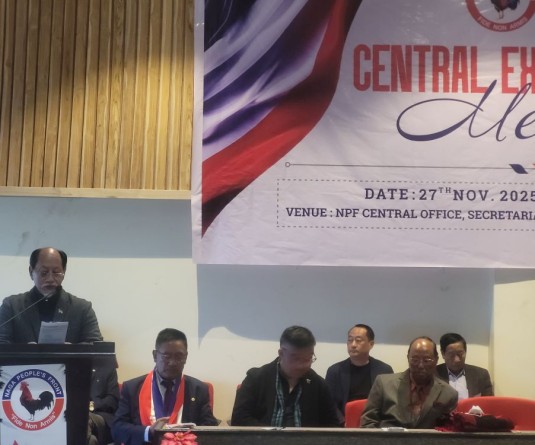
Bringing down the walls of hatred
Philatim Jagoi
Orchid of the Dark Forest, a short novella written by Inovi Awomi is set in the 1960s in a Sumi village known as Hoishe. A fiction blended with romance and conflict is based on folklore and the characters portrayed in the book are the members of two rival families from two different clans viz., the Xi and Xu.
The protagonists - Semato and Nagaholi are the son and daughter of the two families belonging to rival clans. The two love smitten youths are ready to overcome the wall of hatred existing between their families through their love and eventually transcend it, albeit with a tragic end. Their love, although it failed to unite them, brings a change in the village’s existing legend.
The writer begins the book with a narrative scene of the villagers celebrating the Ahuna festival wherein he also gives a brief highlight of the festival. The writer tells about the hostility of the two families - a clash occurs among the boys in the beginning. He also gives a vivid description of the custom and lifestyle of the villagers, and portrays a typical Sumi community in particular, and the Nagas in general when he describes about the morung and the routine cultivation of fields by groups of young people. The profound love, conversations and the rendezvous between the lovers in secluded parts of the village is superb and made to let the readers wonder if the village really did exist. There are also a few scenes of humour in the novella. For instance, he writes “...dispersed with bruises, some leaping...they helped each other...as they were mostly half-blinded by punches on their eyes” but later on thanking one another saying “oshikimthi (thank you)”.
The plot of the story more or less continues to stay the same until the love story of Semato and Nagaholi gets discovered by the latter’s mother. The tragedy of love starts – the girl’s parents arranged another man for Nagaholi to marry. Another important character is an old unmarried woman Iholi who tries to unite the lovers. A series of events that took place in the village caused another predicament - Iholi dies suddenly, the granary belonging to Nagaholi’s family was burnt not long after her death, and Nagaholi’s grandmother dies tragically after a few days. At the same time, Nagaholi finds out she is pregnant, and she is continuously confronted by the dead woman in her dreams. The dreams were signs of a much greater tragedy which were to take place eventually. Furthermore, the village’s legend of the ‘dark forest’, ‘dark song’ and the ‘orchid of the dark forest’ all merged together in a suspenseful manner to bring the story to a strange and tragic end.
The male protagonist Semato is portrayed as a patient and timid young man unlike his violent and aggressive elder brothers. The story revolves around a mixture of dreams, curses, blessings, legends and legacies presenting the readers with a better knowledge of the Naga folklore. The hospitality and generous attitude of the Sumi community is also shown in the scene where the villagers offer their help by giving various items to the girl’s family when their granary gets burnt. The writer tries to carefully showcase the everyday life and attitude of the earlier Sumis through his depiction of the activities, food habits, conversations and behaviour and brings out the local colour of a distinctive Sumi village.
As a story teller, the author avoided the use of difficult words throughout the story. The atmosphere of the story improves in the later part of book and captures the attention of the readers once more making up for the previous static scenes in the process. However, readers’ disappointment in the end would be when they find out the story without climax. Although the drama was fine, a better use of dictions, quality editing of the grammatical errors would have enhanced the quality of the book. Nonetheless, it is a pretty attempt of an enthusiastic writer. Aptly titled, the plot is brilliant filled with bits of folklore, legend and history which allow the reader to learn more about the unique Naga culture in the past.






